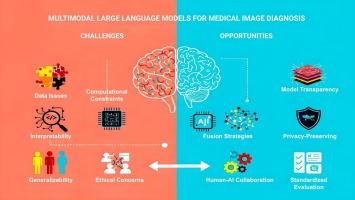Multimodal large language models for medical image diagnosis: Challenges and opportunities
IF 4.5
2区 医学
Q2 COMPUTER SCIENCE, INTERDISCIPLINARY APPLICATIONS
引用次数: 0
Abstract
The integration of artificial intelligence (AI) into radiology has significantly improved diagnostic accuracy and workflow efficiency. Multimodal large language models (MLLMs), which combine natural language processing (NLP) and computer vision techniques, hold the potential to further revolutionize medical image analysis. Despite these advances, their widespread clinical adoption of MLLMs remains limited by challenges such as data quality, interpretability, ethical and regulatory compliance- including adherence to frameworks like the General Data Protection Regulation (GDPR) − computational demands, and generalizability across diverse patient populations. Addressing these interconnected challenges presents opportunities to enhance MLLM performance and reliability. Priorities for future research include improving model transparency, safeguarding data privacy through federated learning, optimizing multimodal fusion strategies, and establishing standardized evaluation frameworks. By overcoming these barriers, MLLMs can become essential tools in radiology, supporting clinical decision-making, and improving patient outcomes.

医学影像诊断的多模态大语言模型:挑战与机遇
人工智能(AI)与放射学的集成显著提高了诊断准确性和工作流程效率。多模态大语言模型(mllm)结合了自然语言处理(NLP)和计算机视觉技术,具有进一步革新医学图像分析的潜力。尽管取得了这些进展,但mllm的广泛临床应用仍然受到数据质量、可解释性、道德和法规遵从性(包括遵守《通用数据保护条例》(GDPR)等框架)、计算需求以及不同患者群体的通用性等挑战的限制。解决这些相互关联的挑战为提高mlm的性能和可靠性提供了机会。未来研究的重点包括提高模型透明度、通过联邦学习保护数据隐私、优化多模态融合策略以及建立标准化评估框架。通过克服这些障碍,mllm可以成为放射学的重要工具,支持临床决策,改善患者的预后。
本文章由计算机程序翻译,如有差异,请以英文原文为准。
求助全文
约1分钟内获得全文
求助全文
来源期刊

Journal of Biomedical Informatics
医学-计算机:跨学科应用
CiteScore
8.90
自引率
6.70%
发文量
243
审稿时长
32 days
期刊介绍:
The Journal of Biomedical Informatics reflects a commitment to high-quality original research papers, reviews, and commentaries in the area of biomedical informatics methodology. Although we publish articles motivated by applications in the biomedical sciences (for example, clinical medicine, health care, population health, and translational bioinformatics), the journal emphasizes reports of new methodologies and techniques that have general applicability and that form the basis for the evolving science of biomedical informatics. Articles on medical devices; evaluations of implemented systems (including clinical trials of information technologies); or papers that provide insight into a biological process, a specific disease, or treatment options would generally be more suitable for publication in other venues. Papers on applications of signal processing and image analysis are often more suitable for biomedical engineering journals or other informatics journals, although we do publish papers that emphasize the information management and knowledge representation/modeling issues that arise in the storage and use of biological signals and images. System descriptions are welcome if they illustrate and substantiate the underlying methodology that is the principal focus of the report and an effort is made to address the generalizability and/or range of application of that methodology. Note also that, given the international nature of JBI, papers that deal with specific languages other than English, or with country-specific health systems or approaches, are acceptable for JBI only if they offer generalizable lessons that are relevant to the broad JBI readership, regardless of their country, language, culture, or health system.
 求助内容:
求助内容: 应助结果提醒方式:
应助结果提醒方式:


